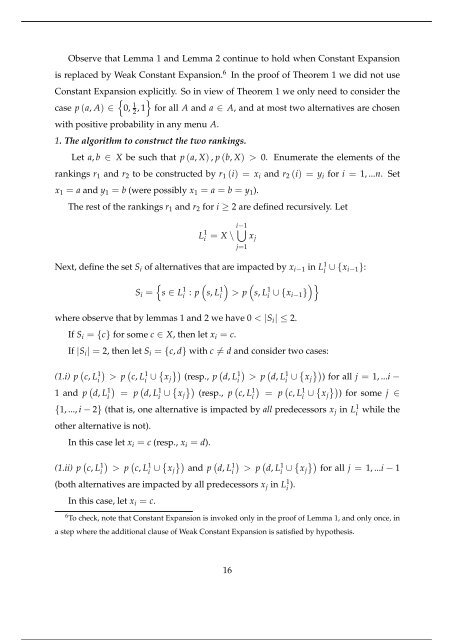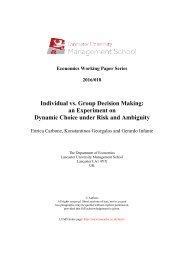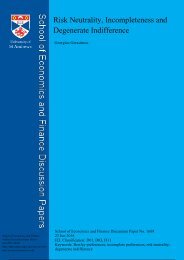Dual Random Utility Maximisation
n?u=RePEc:san:wpecon:1605&r=upt
n?u=RePEc:san:wpecon:1605&r=upt
Create successful ePaper yourself
Turn your PDF publications into a flip-book with our unique Google optimized e-Paper software.
Observe that Lemma 1 and Lemma 2 continue to hold when Constant Expansion<br />
is replaced by Weak Constant Expansion. 6 In the proof of Theorem 1 we did not use<br />
Constant Expansion explicitly. So in view of Theorem 1 we only need to consider the<br />
}<br />
case p (a, A) ∈<br />
{0, 1 2 , 1 for all A and a ∈ A, and at most two alternatives are chosen<br />
with positive probability in any menu A.<br />
1. The algorithm to construct the two rankings.<br />
Let a, b ∈ X be such that p (a, X) , p (b, X) > 0. Enumerate the elements of the<br />
rankings r 1 and r 2 to be constructed by r 1 (i) = x i and r 2 (i) = y i for i = 1, ...n. Set<br />
x 1 = a and y 1 = b (were possibly x 1 = a = b = y 1 ).<br />
The rest of the rankings r 1 and r 2 for i ≥ 2 are defined recursively. Let<br />
L 1 i = X \<br />
Next, define the set S i of alternatives that are impacted by x i−1 in L 1 i ∪ {x i−1}:<br />
S i =<br />
i−1 ⋃<br />
j=1<br />
{ ( ) (<br />
)}<br />
s ∈ L 1 i : p s, L 1 i > p s, L 1 i ∪ {x i−1}<br />
where observe that by lemmas 1 and 2 we have 0 < |S i | ≤ 2.<br />
If S i = {c} for some c ∈ X, then let x i = c.<br />
If |S i | = 2, then let S i = {c, d} with c ̸= d and consider two cases:<br />
(1.i) p ( c, L 1 i<br />
) > p<br />
(<br />
c, L<br />
1<br />
i<br />
∪ { x j<br />
})<br />
(resp., p<br />
(<br />
d, L<br />
1<br />
i<br />
) > p<br />
(<br />
d, L<br />
1<br />
i<br />
∪ { x j<br />
})<br />
) for all j = 1, ...i −<br />
1 and p ( d, L 1 i<br />
) = p<br />
(<br />
d, L<br />
1<br />
i<br />
∪ { x j<br />
})<br />
(resp., p<br />
(<br />
c, L<br />
1<br />
i<br />
) = p<br />
(<br />
c, L<br />
1<br />
i<br />
∪ { x j<br />
})<br />
) for some j ∈<br />
{1, ..., i − 2} (that is, one alternative is impacted by all predecessors x j in L 1 i<br />
while the<br />
other alternative is not).<br />
In this case let x i = c (resp., x i = d).<br />
(1.ii) p ( c, L 1 i<br />
) > p<br />
(<br />
c, L<br />
1<br />
i<br />
∪ { x j<br />
})<br />
and p<br />
(<br />
d, L<br />
1<br />
i<br />
) > p<br />
(<br />
d, L<br />
1<br />
i<br />
∪ { x j<br />
})<br />
for all j = 1, ...i − 1<br />
(both alternatives are impacted by all predecessors x j in L 1 i ).<br />
In this case, let x i = c.<br />
6 To check, note that Constant Expansion is invoked only in the proof of Lemma 1, and only once, in<br />
a step where the additional clause of Weak Constant Expansion is satisfied by hypothesis.<br />
x j<br />
16






